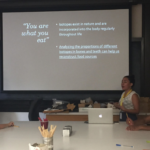Summer SAVY 2018: Session 1, Day 4 – Bioarchaeology (Rising 5th and 6th)
This morning, we took a field trip! The students were able to train like real bioarchaeologists in the Vanderbilt Osteology Lab on main campus. They were able to see some real skeletons, including some pretty cool animals! Our discussion started by explore how “you are what you eat” with dietary isotopes. We learned how to analyze bones and teeth for certain isotopes to hypothesize what ancient diets may have been like, and how that helps us interpret past societies.
With this information, the students then headed to the Bioarchaeology Stable Isotope Research Lab where they had the opportunity to learn how to use a dremel drill to sample dental enamel, a pipette to practice adding “chemicals” (water), and a vortexer to shake up the samples.
After our busy morning, we headed back to the classroom to learn about trauma. We can tell a lot about trauma based on the types of lesions found on the bones, as well as the way that they have healed, or not. Trauma to the bones includes fracture, dislocation, blunt and sharp force trauma. Just by looking at these traumas, we can estimate when and how the trauma happened. There are signs that let us know if it occurred antemortem (before death), perimortem (around death), or postmortem (after death). Once we knew how to analyze trauma on the bones, the students were able to practice by analyzing different bone models and use their newfound knowledge to estimate what kind of trauma they observed, when it happened, and what caused it.
We ended our day by designing crime scenes for open house tomorrow. In groups, students drew from what they have learned throughout the week to create a mystery for their peers (and hopefully their parents!) We really look forward to sharing our classroom with you tomorrow!
Dinner conversation
Ask your student to explain how nitrogen isotopes travel through the food chain (and the surprising individuals at the very top of the food chain!)
http://www.pbs.org/time-team/experience-archaeology/isotope-analysis/
Ask your student to tell you about the difference between ante, peri, and post-mortem trauma, and how osteoblasts help to heal bone.
Further reading: How these skills transfer to forensic anthropology
http://www.sciencemag.org/careers/2002/06/skeleton-keys-how-forensic-anthropologists-identify-victims-and-solve-crimes
Field trip to Tung Lab and Learning how Anthropologists use Enamel to gain Information about the Past



